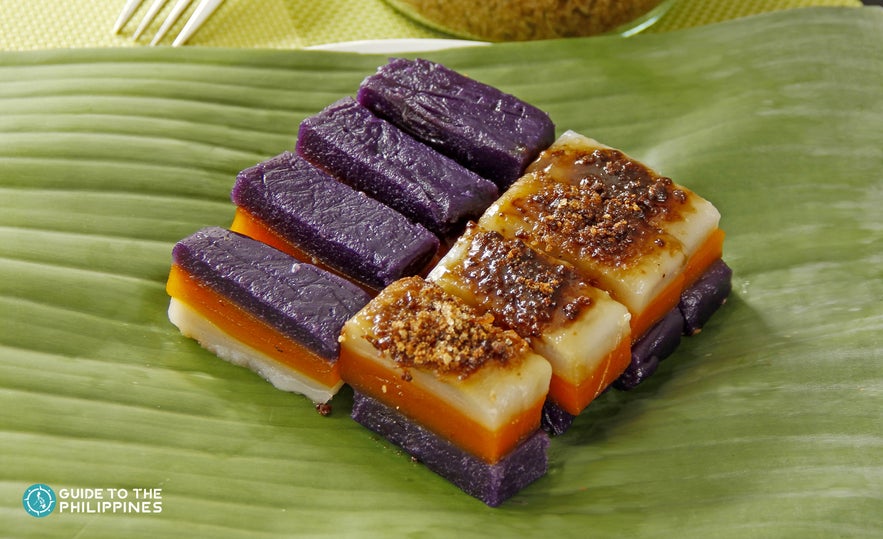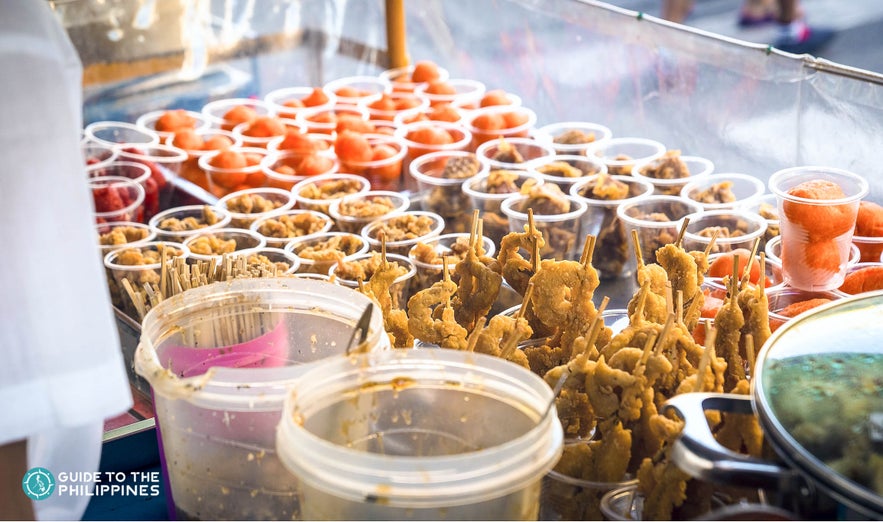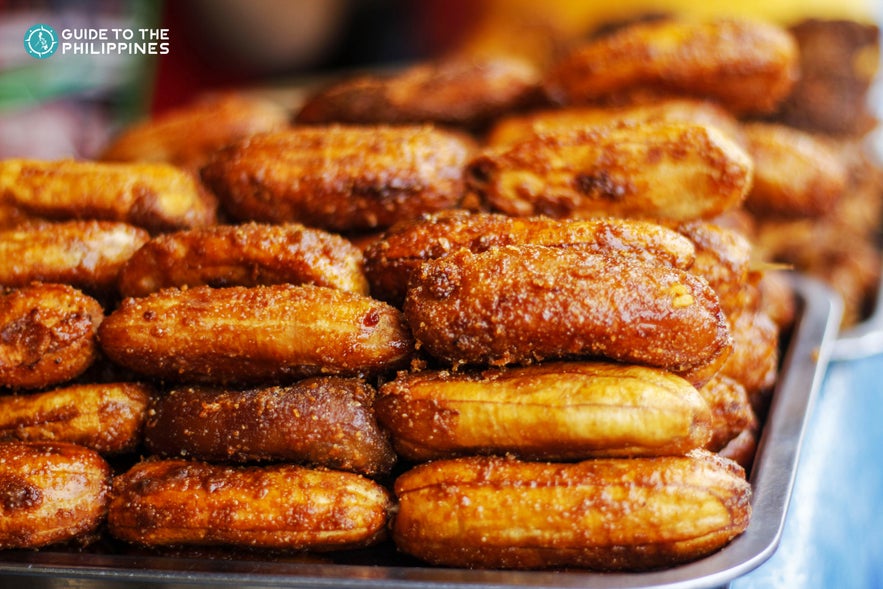
Does the prospect of eating 7 meals a day sound appealing to you, or does it sound absolutely crazy? In the Philippines, locals love to enjoy merienda or snacks at various times of the day, so the concept of enjoying 7 meals in a day is not only possible, it’s not as unusual as you think!
Merienda Culture in the Philippines

Merienda, which mostly means a light afternoon snack in Europe and Latin America, is a term that was passed on to the Filipino people during the colonization of the country by Spain. Currently, the term (also called minindal in Filipino) is now a generic term for snacks or meals outside the traditional staples of breakfast, lunch, or dinner.
There are a number of small meals or snacks that Filipinos enjoy. There is a light meal before breakfast, mostly taken by manual laborers like fishermen and farmers to keep their energy up.
There is also a mid-morning merienda, enjoyed around 10 in the morning between breakfast and lunch, and the traditional afternoon merienda usually enjoyed around 3-5 in the afternoon between lunch and dinner.
Because of the Philippines’ drinking culture, locals also enjoy a version of a midnight snack, to satisfy cravings brought on by a drunken buzz.
Merienda in the Philippines can mean sweet or savory fare and they can range from a few bites to maybe even something as filling as a main meal.
Sometimes, leftovers from a main meal can be converted into a merienda, like the previous night’s pancit canton (stir-fried noodles) placed in between pan de sal to make a sandwich or bananas about to over ripen are dipped in batter and then fried (often called maruya).
There are very little rules defining what a Filipino merienda can be, and it seems that the most important one is that it should be delicious. Here are just a few examples to enjoy throughout the day.
Morning Filipino Snacks
While most Filipino breakfasts are really filling, locals still enjoy a snack either before or after. Here are some of the classic morning merienda enjoyed in the Philippines:
Pan de Sal
 Probably the most well-known of Philippine breads, many locals typically devour 2-3 pieces of this before going to or on the way to work. Eaten plain, with butter or with edam cheese, pan de sal is actually an old Spanish recipe for bread with salt.
Probably the most well-known of Philippine breads, many locals typically devour 2-3 pieces of this before going to or on the way to work. Eaten plain, with butter or with edam cheese, pan de sal is actually an old Spanish recipe for bread with salt.
Filipino incarnations have turned the recipe sweeter to cater to local tastes. Another Filipino way to enjoy the pan de sal is to dip it in coffee.
Taho
 It’s a common sight to see vendors roaming the streets selling taho. Japanese style soft tofu is served with a brown sugar syrup and tapioca pearls. The chewy tapioca pearls provide some great texture contrast with the soft tofu.
It’s a common sight to see vendors roaming the streets selling taho. Japanese style soft tofu is served with a brown sugar syrup and tapioca pearls. The chewy tapioca pearls provide some great texture contrast with the soft tofu.
Served warm, it’s a great way to warm up and to get some protein early in the morning. Modern modifications of this recipe have begun to pop up, including ube (purple yam) and strawberry versions.
Binatog
Steamed white corn kernels are mixed with shredded coconut and then lightly salted, Binatog is definitely the perfect antidote if hunger pangs are serious in the morning. It’s simple and it’s filling and when one is hungry, there’s very little else you require than this.
Maja Blanca
Also called Tibok Tibok, carabao’s milk (or coconut milk) is sweetened and cooked to slowly reduce until thick (sometimes arrow root flour is added) to form a pudding. It is usually topped with crunchy, caramelized bits of coconut milk.
A variation would include corn kernels, sometimes referred to as Maja Mais. A sweet treat that’s relatively inexpensive to make, it nicely complements a cup of coffee too.
Puto Bumbong
 Traditionally available only during the Christmas season, puto bumbong’s popularity has made it available throughout the year now. Rice cakes, tinted purple, are steamed in bamboo tubes and served warm with a large smear of margarine, muscovado sugar and shredded coconut.
Traditionally available only during the Christmas season, puto bumbong’s popularity has made it available throughout the year now. Rice cakes, tinted purple, are steamed in bamboo tubes and served warm with a large smear of margarine, muscovado sugar and shredded coconut.
The rice cakes are chewy and contrasted texturally by the fresh coconut and the bits of sugar. It is definitely hard to resist.
Afternoon Filipino Snacks
The time between lunch and dinner is a long one, which means afternoon merienda is definitely an integral part in surviving the day. Here are some local favorites:
Kakanin
 Kakanin is a blanket term that refers to a number of sweet cakes made with either glutinous rice, tapioca or cassava.
Kakanin is a blanket term that refers to a number of sweet cakes made with either glutinous rice, tapioca or cassava.
The most popular ones include Puto, a sweet flour cake that’s steamed and usually topped with processed cheese. Sapin Sapin, chewy glutinous rice cakes in different colors that are served with crunchy caramelized shredded coconut.
Kutsinta, a bouncy, chewy tapioca flour cake served with freshly-shredded coconut, and Pichi Pichi, made from grated cassava and rolled in either shredded coconut or grated processed cheese.
Pancit
 There is definitely a plethora of pancit (noodle) dishes in the Philippines that locals love, and any or all of them are perfect as mid-afternoon snacks. The most popular ones are the Pancit Canton and Pancit Sotanghon, noodles stir-fried with meat, shrimp, and vegetables.
There is definitely a plethora of pancit (noodle) dishes in the Philippines that locals love, and any or all of them are perfect as mid-afternoon snacks. The most popular ones are the Pancit Canton and Pancit Sotanghon, noodles stir-fried with meat, shrimp, and vegetables.
Another popular one is the Pancit Palabok, which are rice noodles with a thick orange sauce made with crab fat, topped with fried smoked milkfish, chicharon (fried pork skin), and hard-boiled egg.
Also quite popular is the Filipino Spaghetti, pasta served with ground pork or beef, hotdogs tinted red and a sweet and savory sauce made with tomato sauce and banana catsup.
Empanada
 Photo by the Philippine Department of Tourism
Photo by the Philippine Department of Tourism
Another foreign recipe that was passed on and later modified by Filipinos, empanadas are meat and vegetables rolled in a dough and then fried, or sometimes baked.
The most popular version features shredded unripe papaya, white cabbage, longganisa (local garlic sausage) and a raw egg are all in a dough folded in a half-moon shape and then deep-fried.
When freshly cooked, the dough is thin and wonderfully crunchy with the egg barely cooked and runny. It’s best enjoyed with a splash of caramelized sugar cane vinegar.
Street Food

Philippine street food is another go-to for mid-afternoon merienda, especially when people are on the way home. There is a variety of grilled and fried items available, usually served on or with sticks.
The most popular ones include pork barbecue (pork shoulder marinated and grilled), isaw (grilled chicken or pork intestines), banana cue (fried and caramelized bananas), turon (fried caramelized spring roll wrapped banana) and kwek kwek (tempura-fried hardboiled quail eggs), but the Philippines’ street food list is endless.
Siopao
 The Filipino version of the Cantonese steamed barbecue pork bun, Filipinos have definitely made it their own. Local versions are much larger and while they have the more traditional one, soft fluffy steamed buns with sweet barbecued pork (called asado), there are other versions as well.
The Filipino version of the Cantonese steamed barbecue pork bun, Filipinos have definitely made it their own. Local versions are much larger and while they have the more traditional one, soft fluffy steamed buns with sweet barbecued pork (called asado), there are other versions as well.
Bola bola features a large pork meatball inside the steamed bun. Meanwhile, enterprising locals have added even more fillings. Now, there are siopaos filled with salted duck eggs, banana blossoms, Chinese sausage, shredded chicken and even bacon.
Ginataang Bilo Bilo
 Photo by Foxy Folksy
Photo by Foxy Folksy
Sometimes called ginataan or ginataang halo halo, this sweet stew features root crops like taro, purple yam and sweet potato, bilo bilo (gluinous rice balls), tapioca balls, saba (cardava bananas), and sweetened jack fruit, all stewed in coconut milk.
It can be enjoyed warm or room temperature and it is particularly comforting when one is tired or not feeling well.
Evening Filipino Snacks
After a night of drinking, locals usually look to have one more meal before heading home. These can hardly be called snacks because they are filling and extremely satisfying.
Lugaw
Rice porridge, similar to a congee, served piping hot will definitely remove the buzz from drinking. Cooked and served with chicken (arroz caldo) or with beef tripe (goto), lugaw is also best enjoyed with crisp bits of fried garlic, a dash of black pepper, a squeeze of calamansi (local citrus) and a few drops of patis (fish sauce).
Lugaw is hot, filling, and loaded with umami. It's definitely best enjoyed late at night. Most lugaw joints are open until the wee hours of the morning or operate 24/7, that's why it's a classic snack for those who have just finished drinking with friends.
Pares

Photo by Goto Tendon
As legends go, a drunk man desperately wanted beef mami (beef noodle soup), but the vendor had run out of noodles. He managed to convince the drunk diner to enjoy the beef with some rice instead and the pares was allegedly born.
It’s beef, stewed for hours in soy sauce, star anise and five-spice powder and the resulting sweet and salty stew poured over garlic fried rice is a pair that brings a satisfaction rarely matched when one is drunk and hungry late at night.
These are usually found in food carts found in busy street intersections or nearby bus terminals for hungry travelers.
Bulcachong/Kaleskes
While Bulcachong and Kaleskes may not be exactly the same dish, they are similar in that they feature carabeef (water buffalo) and they are wildly popular late after the sun sets.
Enjoyed while or after drinking, all parts of the carabeef are stewed in spices for hours, resulting in meat that’s meltingly tender and a stewing liquid that’s incredibly rich. Eaten on its own or with some steamed rice, it is especially filling and satisfying.
Any Time is the Best Time for Filipino Merienda

As mentioned before, there are very little rules in enjoying a merienda or a snack in the Philippines. Snacks typically enjoyed in the morning can be enjoyed late at night and vice versa.
Merienda can be as filling as one needs or it can be just a few small bites to pass the time. Perhaps, the only rule to keep in mind is that to truly have the Filipino dining experience, one has to go beyond the 3 square meals and enjoy a snack or two or three.












